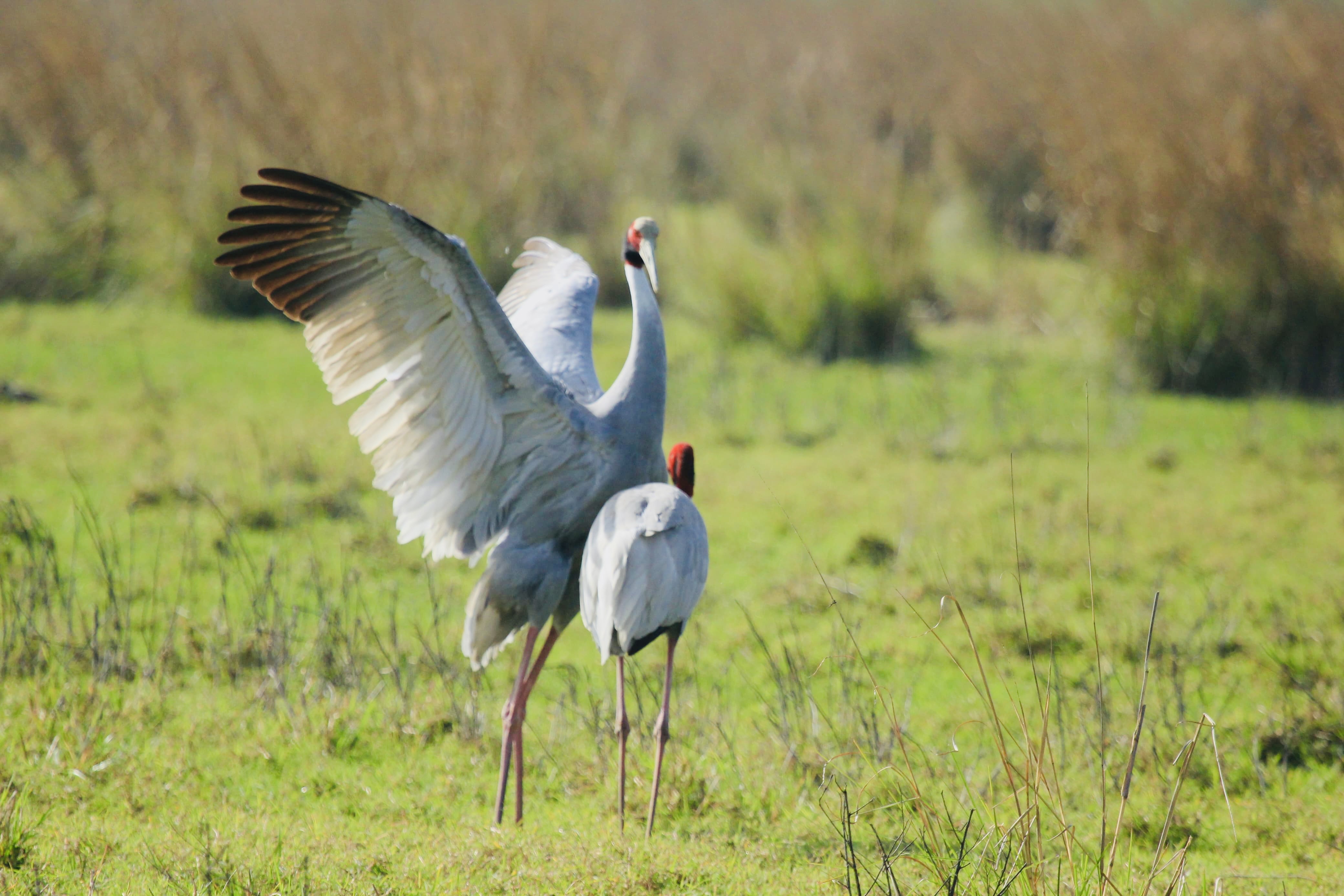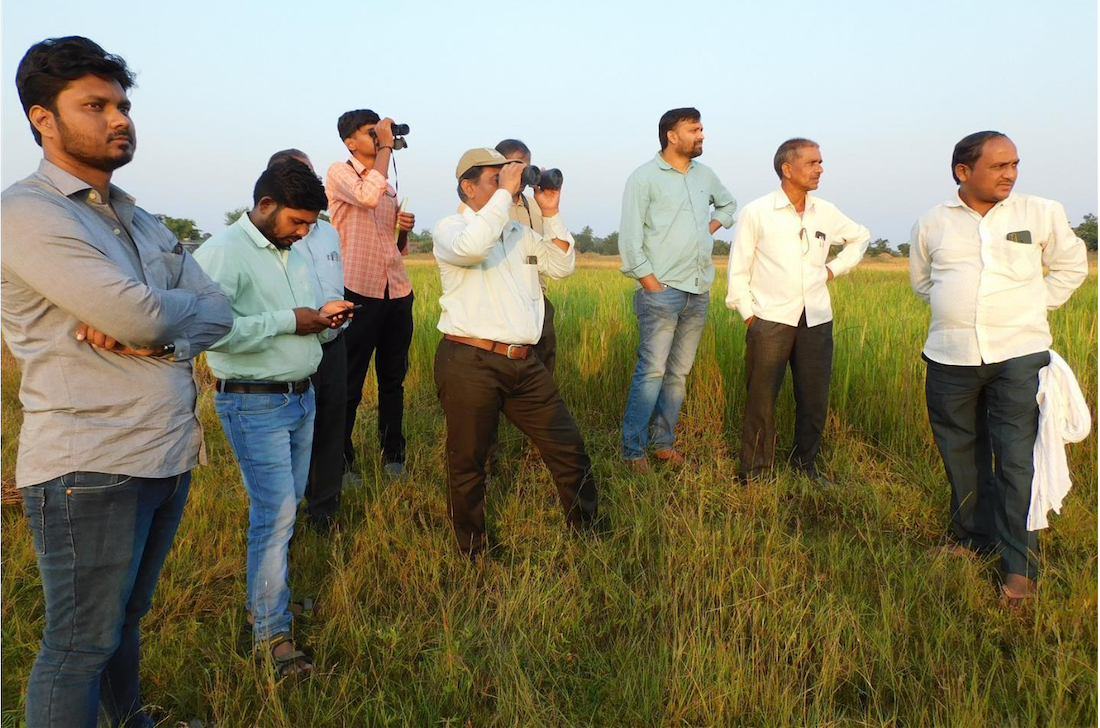They symbolise eternal, unconditional love and inspire timeless tales of devotion, passion, poetry, art, and architecture. They are believed to be harbingers of good fortune whose presence indicates the sound health of wetland ecosystems. They are the sarus cranes, the world’s tallest flying birds. However, these birds we associate with all things positive are no longer safe today. Human activities threaten these birds and their wetland habitats across their range in South and Southeast Asia and Australia. Thus, the Bombay Natural History Society (BNHS) has recently launched a project to protect these birds in the Vidarbha region of Maharashtra, India. The project aims to assess the populations and habitat quality of the sarus cranes in the area and implement conservation strategies to safeguard their wetland habitats for a secure future for all.
The Sarus Crane In Indian Culture

In India, the sarus crane has long been loved and revered. In fact, the bird’s name, sarus, comes from the Sanskrit word “sarasa,” meaning “bird of the lake.” These birds are known to mate for life. According to researchers who have studied their behaviour, sarus crane pairs are inseparable. These non-migratory birds eat, sleep, fly, walk, and do everything together, including sharing the responsibility of building a nest and bringing up the offspring. They also celebrate the hatching of an egg with unison calls. Even when in flocks, outside the breeding season, pairs stay closer to each other than to other birds.
Such behaviour of the sarus crane has inspired numerous legends and folklore. The bird is even said to have inspired sage Valmiki, who wrote the great Indian epic Ramayana. It is said that the sage was wondering how to present Rama’s story when he witnessed a mating pair of sarus cranes meet an unfortunate end. A hunter’s arrow struck the male, who died before the eyes of the female. The female heavily grieved the loss of her beloved partner. Valmiki was filled with sorrow and anger at this sight and cursed the hunter in fine verse. This incident lived on in his heart, and later, while writing the Ramayana, he could relate the sorrow of the grieving female he witnessed to that of Rama’s wife, Sita, who was abducted by Ravana and separated from her husband.

The sarus crane also finds mention in the poetry of Kalidasa, considered the greatest poet and writer of ancient India, and in the story of Lord Buddha, the founder of Buddhism. Ancient scriptures considered the consumption of sarus crane meat a taboo. However, during colonial rule in India, these birds were extensively hunted, and young birds often landed on the plates of the British.
Even today, there are rituals in parts of India where newlywed couples view this bird for a blessed future together. The Gond tribal people also consider the bird as sacred.
The Sarus Struggles To Survive
Globally, around 15,000 mature individuals of the species are estimated to survive. The sarus crane is labelled as “Vulnerable” on the IUCN Red List. In India, the species is awarded the highest degree of protection as a species in Schedule I of the Wildlife Protection Act.
However, despite all the positive sentiments associated with sarus cranes in India and the legal protection granted to them, these birds haven’t been able to escape the wanton destruction of habitats happening in the country.
The excessive drainage of wetlands and their conversion into agricultural lands is a major threat. Human disturbances in the remaining habitats also adversely affect their breeding success. Ingestion of contaminants like pesticides used in agriculture threatens the health of these birds. Poaching is another cause of their decline, as these birds are hunted, or their eggs and chicks are collected for food, traditional medicines or illegal pet trade. Also, predation of chicks and eggs by feral dogs and corvids is another threat. Electrocution due to collision with power lines is also known to be lethal to sarus cranes.

Historically, the sarus crane was widely distributed across the Gangetic plains of northern India to the Godavari River in the south. In the east, it was found as far as West Bengal and Assam, while to the west, it was found near the coastal areas of Gujarat.
Today, the bird is rarely seen in Assam and West Bengal and has disappeared from Bihar. Its southernmost population of only around 100 birds is limited to a small area in Maharashtra and Madhya Pradesh. In the former state, it occurs in eastern Vidharbha, a geographical region of Maharashtra involving the three districts of Gondia, Chandrapur, and Bhandara.
However, even in Vidarbha, the sarus crane population has plummeted. No breeding populations now occur in the Bhandara and Chandrapur districts, with most of these birds in Vidarbha confined to the Gondia district along the Bagh and Wainganga rivers. The sarus crane here faces numerous threats, like habitat loss, poaching, electrocution and toxicity due to pesticide use in agricultural fields.
The BNHS Study
Since the population of Sarus cranes in Vidarbha is declining and under threat, BNHS has decided to study various parameters to understand the dynamics of the sarus crane population in the region so that conservation strategies can be designed and implemented to protect these birds there.
In this direction, the BNHS and the Maharashtra Forest Department (MFD) jointly launched a project, “Research, monitoring and conservation of the Vulnerable Sarus Cranes in Vidarbha region, Maharashtra” in August 2023.

BNHS Team visited wetlands near Shivani, Gondia, which are potential areas for the sarus cranes. Image credit: BNHS
The BNHS research team identified sarus crane habitats in Vidarbha as part of the study in the latter half of 2023. These birds prefer wetlands, marshy areas, grasslands, agricultural fields, and shallow water bodies as habitats. The team is now trying to elucidate the status and habitat use by Sarus cranes in Vidarbha, the nesting and breeding success, dispersal and movement pattern of the species, the territorial quality, the threats to the species, and the conservation measures to be adopted to address the threats. The BNHS team is also coordinating with all the local stakeholders to decide the best interventions to save the sarus cranes of Vidarbha. Work is going on and results from the study will help decide conservation interventions to protect the sarus cranes and their habitat in Vidarbha.
It is only in-depth research studies and sound conservation interventions that can help protect these disappearing birds. Sarus cranes are opportunistic omnivores, helping keep wetland ecosystems in balance by keeping the populations of invertebrates and other species in control. Protecting them translates to saving wetland habitats, which provide vital ecosystem services to us like carbon sequestration, prevention of floods, groundwater recharge, freshwater source, biodiversity protection, and more.
To support BNHS in research and conservation work, please click on the link below: https://www.bnhs.org/donate

